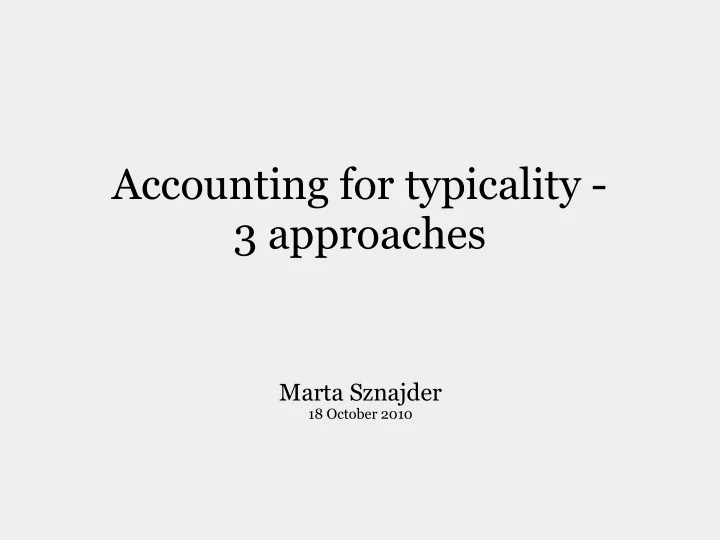

Accounting for typicality - 3 approaches Marta Sznajder 18 October 2010
Overview INTRODUCTION PROTOTYPE VIEW - best example - summary representation - feature combinations - schemata EXEMPLAR VIEW - similarity calculation - defining exemplars - the Generalized Context Model KNOWLEDGE APPROACH CONCLUSION
INTRODUCTION Last week: The classical view on categories - definitional approach. Typicality phenomena. Three kinds of theories that arose after the classical view was rejected. How to account for typicality. Two questions to answer: - what is the structure of a category - categorization of new items
PROTOTYPE VIEW Eleanor Rosch - provided much of the evidence for problems with definitional approach - number of alternatives to the classical view Prototype view: entire category is represented by a unified representation.
PROTOTYPE VIEW Best Example Category represented by a single ideal member. Shortcomings: - can't encompass contradictory features - no information about variability of the category
PROTOTYPE VIEW Summary Representation Concept represented as features usually found in the members of the category. The more often the feature appears, the higher its weight. List might contain contradictory features. Problem: continuous dimension - take the average? Sometimes impossible. Categorization of new items: calculating the similarity of the item to the list; categorization criterion - the critical value for the item to be categorized. Explains: lack of definitional features, borderline cases, why people change their minds, faster categorization of typical items, intransitive category membership judgements.
PROTOTYPE VIEW Feature Combinations + Schemata More recent developments: Feature combinations: Category representation should keep track of how often features occur in category members. Elaborate: sets of features. Leads to computational explosion. Schemata: No relations between the features on a feature list. Schema = structured representation; divides the properties of an item info dimensions (=slots) and values for those dimensions (=fillers). Slots can restrict their fillers, but also each other. Motivation: people structure the information they learn. Still, feature lists are a useful shortcut for experiments.
EXEMPLAR VIEW The Context Model of Medin and Schaffer Rejection of the idea of a representation of the entire concept! A concept is just the set of exemplars. To make judgements about members of the category we consult our memory. To categorize - compute similarity to other category members. Easily explains typicality, faster categorization of typical items, category intransitivity. No defining characteristics - no problems of the classical view.
EXEMPLAR VIEW Similarity Calculation A way to identify similar exemplars. Multiplicative rule: 1. Identify which aspects of two items are shared and which are not. 2. For the positive ones: how important is this dimension to determining similarity? 3. For mismatching features: how mismatching are they? For every feature a number from [0,1] is given - matching features get 1. Then: multiply scores. For comparing with a whole category - add up! Property of the rule: best to be very similar to a few items, not helpful to be somewhat similar to many items.
EXEMPLAR VIEW Defining Exemplars First: when are items recorded as exemplars? A brief encounter? Seeing on the way to work? - This is a more general question about human memory. How to define an exemplar? Do types or tokens matter? Suppose I see one dog every day? Empirical results (Nosofsky) suggest that an exemplar is not an actual thing but rather an encounter with a thing.
EXEMPLAR VIEW Generalized Context Model Enhancement of the Context Model - lots of formalism added. Multiplicative rule replaced by more general distance measure. Distance measure: between an item and all the known exemplars. Euclidean measure with respect to dimensions (color, size, ...). Distance vs. similarity: The greater the distance, the smaller the similarity. Categorization decision: which category exemplars are most like the object being categorized. Takes the similarity of the item too all objects in the category and compares similarities to categories (how much of the total similarity measure comes from which category). The formula is probabilistic - but people do not always choose the most likely answer, so it is ok.
KNOWLEDGE APPROACH Approach developed in reaction to the first two. Concepts are part of our general knowledge about the world - we learn concepts as part of our overall understanding of the world around us. Pressure for concepts to be consistent with whatever else we know. Schemata - one way of representing the knowledge about the domain. Important of such knowledge apparent in case of goal-derived categories (Barsalou) - defined solely wrt some goal or plan. In such cases very little of category structure can be explained by family resemblance. Limitations: Much of a concept cannot be based on previous knowledge. No empirical learning mechanism (yet?).
CONCLUSION None of the three presented approaches suffers from problems of the classical view. Typicality phenomena are not an anomaly, but are inherent to the approach. But these three theories are not self-contained - they contain references to each other.
Recommend
More recommend